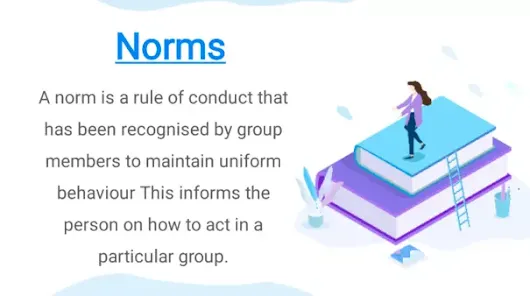Table of Contents:
- Norms Meaning
- What are Group Norms?
- Group Norms Meaning
- Types of Group Norms
- Development of Group Norms
- Assumptions Related to Group Norms
- Issues in Group Norms
Norms Meaning
“Norms” are the unwritten rules that govern social behaviour and interactions. It informs the person how to act within a particular group or society. They serve as a guide for individuals to understand what is considered acceptable or unacceptable behaviour in a given situation. A norm is a rule of conduct that has been recognised by group members to maintain uniform personal and group behaviour. It can vary depending on social, cultural, and historical contexts. When norms are agreed to and accepted by the group, they serve as a method of influencing the behaviour of the group members with the least external controls. All groups, communities and societies have some norms however they can differ among them.
What are Group Norms?
Group norms are “the oughts” or “should be” behaviour. They comprise sets of beliefs, feelings and attitudes shared commonly by the group members. These are also called rules or standards of behaviour that apply to members of the group. All groups have established norms, that is, satisfactory standards of behaviour that are exchanged by the members of the group. Norms inform members what they should do and what they should not do in certain situations thereby governing the behaviour of the group members.
Group Norms Meaning
According to Argyle, “Group norms are rules or guidelines of accepted behaviour which are established by a group and used to monitor the behaviour of its members”.
According to D.C Feldman, “Group norms are the informal guidelines of behaviour and a code of conduct that provide some order and conformity to group activities and operations. These rules are expected to be followed by all the group members. These norms and rules generally develop gradually and informally as group members learn as to what behaviours are necessary for the group to function effectively”.
Types of Group Norms
Group norms can be classified as given below:
1) Performance Norms: Working groups normally give their members precise ideas about how hard they have to work, how to complete the given job, their degree of output, the exact level of delay that is allowed, etc. These norms control the performance and productivity of each member.
2) Appearance Norms: These incorporate things like suitable dress, loyalty to the workgroup of the organization, etc. Some organisations include formal dress codes.
3) Arrangement Norms: These norms emerge from informal workgroups and especially control social informal workgroups and communication within the group.
4) Resource Allocation Norms: These norms may arise in the group or within the organisation and encompasses things like pay, allotment of difficult job and allocations of new tools and equipment.
Development of Group Norms
Most norms develop in one or more of the following given forms:
1) Clear Statements Made by a Group Member: Clear statements made by the supervisors or powerful members may be considered norms. For example, the supervisor may clearly state that coffee breaks should be limited to ten minutes and this becomes a norm.
2) Critical Events in the Group’s History: Sometimes there is a crucial event in the history of the group to sets an important standard. For example, a person who was standing near a machine got injured in a workgroup. After this accident happened, a standard was established in this group that no one except the operator is permitted to get within five feet of any machine.
3) Primacy: Primacy refers to the initial behaviour pattern that occurs in a group. For example, when the first meeting of the group is conducted in a very formal manner between supervisors and subordinates then the group anticipates future meetings to be conducted similarly.
4) Past Experience: The norms are developed as members bring their past experiences from other groups in different organisations.
Related Article:- Group Decision Making
Assumptions Related to Group Norms
Various assumptions related to groups are as follows:
1) One assumption is that the person exists outside any group and that joining a group is in some form doing something different from everyday life.
2) A second assumption is that entry into a group will take away the autonomy of any individual who enters a group.
3) A third assumption is that there is something God has given about the individual and something less than satisfactory about the power or influence of a group.
4) A fourth assumption is that it is possible for the psychological functioning of an individual to exist independently of the groups to which the individual belongs.
These assumptions are derived from a highly Westernised worldview that is rooted in an unconscious fear of the group, supported by the illusion that human beings are autonomous individuals who can act with “free will’ without reference to or constraint from others.
Issues in Group Norms
There are several distinct types of difficult behaviour which can occur in group nations. The level of success of a group will eventually depend on the level of cohesiveness within the group – how well the group members interact and get along with each other. By understanding, identifying, and minimising disruptive group behaviour, group work becomes more productive and effective. The various issues in group behaviour are as follows:
1) Conflict
Disagreements within groups are common and usually a healthy way of building cohesiveness, this is because if people disagree on a particular point they will have the opportunity to explain why and possibly offer alternative answers to the problems of the group. Conflict and additional discussion can be a good way of reflecting and clarifying the purposes and objectives of the group and can enhance other understanding by taking in the viewpoints of all group members.
Related Article:- What Are Policies
Conflict management becomes a problem only when comments become personal, towards someone or a sub-group of people, or discussion takes up too much time to the detriment of the group’s purpose. Strong group leadership and cohesiveness will enable disagreements to become positive for the group and the individuals within it. An individual in an enabled group may challenge what is being said by the leader or by group members. This can lead to trouble within the group, affecting the improvement and overall emotional state of the other members.
Any sort of challenge or disagreement needs to be discussed sincerely, mainly if there appears to be a valid reason for it. The person in disagreement should be motivated to represent their views positively with the rest of the group. If the situation cannot be fixed in the group setting, the leader or facilitator may wish to discuss the issues which concern the individual away from the rest of the group. Alternatively, the disagreement could be dealt with at a specific time and examined by the group, so that the group as a whole negotiates some form of resolution. Conflict resolution in groups will depend, in part, on the team roles and leadership styles of the group members.
2) Non-participation or Withdrawal
Everyone has the right to participate or not to participate within the group, although it is usually preferable for all members to contribute. Some members will choose to observe rather than participate vocally and others may wish to contribute but feel too shy, fear self-disclosure or lack confidence.
To overcome a lack of self-confidence, where members want to contribute but fear doing so, their non-participation needs a positive, and encouraging approach, however, they should not be embarrassed or pressured to participate.
Some group members who are removed may just take longer to warm up to the group situation and to open up. Over time, group members who were initially quite extroverted may listen more and say less, whilst those who said little initially may begin to say more, which will lead to more balanced contributions
3) Monopolising
There may be times when an individual in the group has a bunch more to say than others. This may be the case, e.g., if one member has a focused area of expertise that needs to be shared with others. Monopolising, however, refers to one or two members dominating the group at the cost of members’ contributions.
Monopolising can lead to irritation from others in the group, feeling that they do not have the chance to make their points. The leader or facilitator may reduce this problem by fit acknowledging what the person has to contribute and then diverting the discussion to other people, asking their opinions and moving on. In situations that cannot be fixed in a group situation, the best approach may be to discuss the problem with the individual concerned, in a way that is sensitive and positive and does not drain their spirits and future contributions altogether.
4) Scapegoating
When things go bad in a group situation it is sometimes easy to direct blame at one or more people within the group. This is known as ‘scapegoating’ and can be very destructive for the person concerned and also for the group as a whole. The person may be abandoned by the group and become a target for frustration, anger, and ridicule by other members. Such behaviour may lead members to withdraw, especially if they are unable or unwilling to defend themselves. Everybody makes mistakes and it is natural for an individual to fail sometimes; scapegoating can be comparable to bullying and may be detrimental to the self-confidence of the victim.
If the group has failed because of someone then a more suitable way of handling the situation would be for the person concerned to have a private discussion with the group leader. Usually, The point of a group is to pull together and support each other. The whole group may be to blame for assigning the wrong tasks to a person or not providing satisfactory support.
In cases of scapegoating, the group leader or facilitator could re-structure the group into sub-groups for a period, to reduce the effect of the whole group scapegoating one individual. Interpersonal interactions may be structured differently in a smaller unit and may help to reconstruct the confidence of members. Re-structuring may also change the dynamics within the group as a whole once it has been fully improved at a future time.
5) Additional Problem Areas
Many other issues may arise within groups, ranging from general negativity to specific problems such as irregular attendance, aggressive behaviour or arguments. The coping strategies of the facilitator or leader will depend primarily on the arrangement of the characteristics of the group, e.g., their abilities, age, motivation and emotional state.
Problems can often be resolved by:
i) Clear guidelines as to the ‘rules’ or ‘norms’ of the group. Many formal groups will negotiate and agree on these rules at an earlier stage.
ii) Positive feedback is given to individual contributions, both from the group leader and other group members.
iii) Where problems do arise, their cause needs to be clearly understood.
iv) Overcoming problems within a group can improve the group’s overall cohesiveness and mutual trust.

You May Also Like:-
Nature of Organisational Behaviour
Conceptual Foundation of Organisational Behaviour
Contributing Disciplines to organisational behaviour
Models of Organisational Behaviour
Approaches of Organisational Behaviour
Emotional Intelligence in Organisational behaviour
Factors Influencing Perception
Scope of Organisational Behaviour
Importance of Organisational Behaviour
Challenges and Opportunities of Organisational Behaviour
Factors affecting group behaviour
Causes of Conflict in an Organisation
Types of Conflict in an Organisation
Organisational Development Process
Factors Affecting Organisational Culture
Trait Theory: Stogdill’s trait factors
